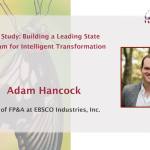In this article, the author considers the essential skills finance professionals need to develop for digital...

The Role of FP&A: Beyond Numbers and Reports
Over the course of my career, I’ve seen various setups of FP&A teams across different organisations. Here, I’d like to share some insights on the evolving role of Financial Planning and Analysis (FP&A) and discuss how we can elevate its impact within our organisations.
Despite the diversity in team structures, I can see two key principles consistently emerge.
First, effective FP&A requires close collaboration with colleagues across departments and functions. Financial data needs to be translated into actionable insights that resonate with diverse company stakeholders. This cross-functional approach is essential for driving informed business decisions.
Second, FP&A must extend their operations beyond traditional financial accounting and reporting. Our role is to serve as a bridge between raw financial data and the strategic decisions that propel business success. It means not just analysing numbers but interpreting them to guide leadership in making sound decisions.
Evaluating FP&A Performance: Room for Improvement
Given the critical nature of FP&A, one might assume that we have mastered this function over the years. However, the reality is more complex. Despite the growing importance of FP&A as a function, many teams still struggle to deliver the value expected.
The 2024 FP&A Trends Survey shows there is room for improvement in critical FP&A activities.
- 63% of companies are unable to make accurate predictions for more than six months into the future, as many organisations are still unprepared to deliver on-demand forecasting. 18% of organisations can produce a forecast within two days.
- 57% of organisations produce an annual budget between one to three months, and only 15% can do so within a month.
- In a fast-changing and fluid business environment, 21% of organisations are still unable to run scenarios.
- Only 35% of FP&A time is spent on driving insights and driving actions.
Clearly, FP&A teams need to improve their capabilities to continue assisting organisations in navigating modern challenges.
The Challenge: Siloed, Linear, and Rigid Processes
One of the primary obstacles hindering FP&A's effectiveness is the persistence of siloed, linear, and rigid processes. In many organisations, FP&A is often viewed as a task-driven function operating within a sequential, end-to-end workflow. This approach isolates FP&A from the broader business context, leading to a fragmented and inefficient process.
FP&A is frequently blamed for being a bottleneck, unable to provide clear explanations or timely insights when issues arise. This frustration stems from a process that prioritises task completion over problem-solving, leaving FP&A disconnected from the strategic goals we are meant to support.
Case Study: Headcount Planning and Forecasting
To illustrate the pitfalls of a siloed approach, consider the example of headcount planning and forecasting in the services industry. In a sector where staff expenses can account for up to 80% of costs, accurate headcount planning is critical.
In a traditional, siloed setup, integrating payroll, staff costs reporting, and forecasting across HR, accounting, and FP&A teams proved challenging. When senior management requested detailed insights, the various teams struggled to respond cohesively. Each function performed its work in isolation, with little understanding of how their data fit into the larger picture. This lack of integration led to confusion, delays, and, ultimately, inefficient decision-making.
The Solution: Adopting a Purpose-Driven Approach
To overcome these challenges, I advocated for a shift towards a purpose-driven process within FP&A. This approach required us to redefine our roles: we had to become problem solvers and strategic partners instead of task executors.
When a business issue arises, or if management faces a complex problem, FP&A should take the lead in identifying this problem, gathering relevant data, conducting a thorough analysis, and offering practical recommendations for tackling it. To do so, FP&A must break free from silos and linear workflows and collaborate fluidly with subject matter experts and other departments.
The 2021 FP&A Trends Research Paper provides valuable insights into how FP&A can shift from a task-driven, traditional management accounting to a purpose-driven, multi-disciplinary function.
- FP&A need to focus on the entire organisation and establish cooperation with other functions.
- Practicing Agile FP&A with more agile sprints, acting as consultants and project managers.
- Aligning strategic and analytical functions, especially around forecasts and outcomes.
- Be an influencer and change agent to the business and leadership.
By embracing a purpose-driven approach, FP&A can transition from being a task-oriented operator to a results-focused contributor, delivering greater value to the organisation.
Key Takeaways for Successful FP&A Transformation
There are three critical areas to focus on:
- Integrated Data Management
In a well-integrated organisation, data should not reside in isolated subsystems. Instead, it should be part of a master data setup accessible across the company.
For example, HR data on workforce management has traditionally resided in a siloed platform under HR’s system, which was not integrated with other FP&A systems. Companies can explore having relevant HR data, which are specific value and cost drivers to financials, to be integrated and accessible to FP&A. We have to set up an organisation-wide standardised taxonomy and definitions of these drivers to ensure consistency in data interpretation and analysis. For instance, the Full-Time Equivalent (FTE) count should be identical across HR and finance to ensure consistency in reporting and analysis.
- Supportive Systems Architecture
Organisational systems must be designed to facilitate collaboration and integration. With the influx of Artificial Intelligence (AI) tools in finance, this will simultaneously become easier and more challenging. Information Systems (IS) expertise is crucial in linking end-to-end systems architecture, enabling seamless data flow and analysis.
For instance, FP&A can collaborate with the IS department to implement an integrated financial planning system that incorporates AI tools for Predictive Analytics and Scenario Modelling. This system links data from various sources, including ERP, CRM, and budgeting software. Such an architecture ensures seamless data flow across departments due to utilising APIs and middleware solutions. For example, sales data is automatically fed into the FP&A system, enabling real-time updates to revenue forecasts based on actual sales performance.
- Cultural Engagement
Lastly, do not underestimate the importance of engaging with finance and non-finance colleagues personally. Invest time in building relationships with stakeholders and subject matter experts when investigating a problem and proposing solutions. This collaborative approach often leads to deeper insights and more effective solutions.
For example, when FP&A spots recurring budget overruns in marketing, they can lead cross-departmental workshops to collaborate with the marketing team to understand their budgeting processes and challenges. During these sessions, FP&A should encourage open discussions about their strategies, upcoming campaigns, and resource allocation. By building relationships through these workshops, FP&A can gain deeper insights into the marketing team’s needs and constraints. This collaborative environment fosters trust and leads to more tailored budgeting solutions, ultimately helping to align financial planning with actual marketing initiatives.
Conclusion
In conclusion, transforming FP&A from a siloed, task-driven function into a purpose-driven powerhouse requires a shift in mindset, processes, and culture. By embracing these changes, we can enhance the value that FP&A brings and drive better business outcomes.
Subscribe to
FP&A Trends Digest

We will regularly update you on the latest trends and developments in FP&A. Take the opportunity to have articles written by finance thought leaders delivered directly to your inbox; watch compelling webinars; connect with like-minded professionals; and become a part of our global community.






